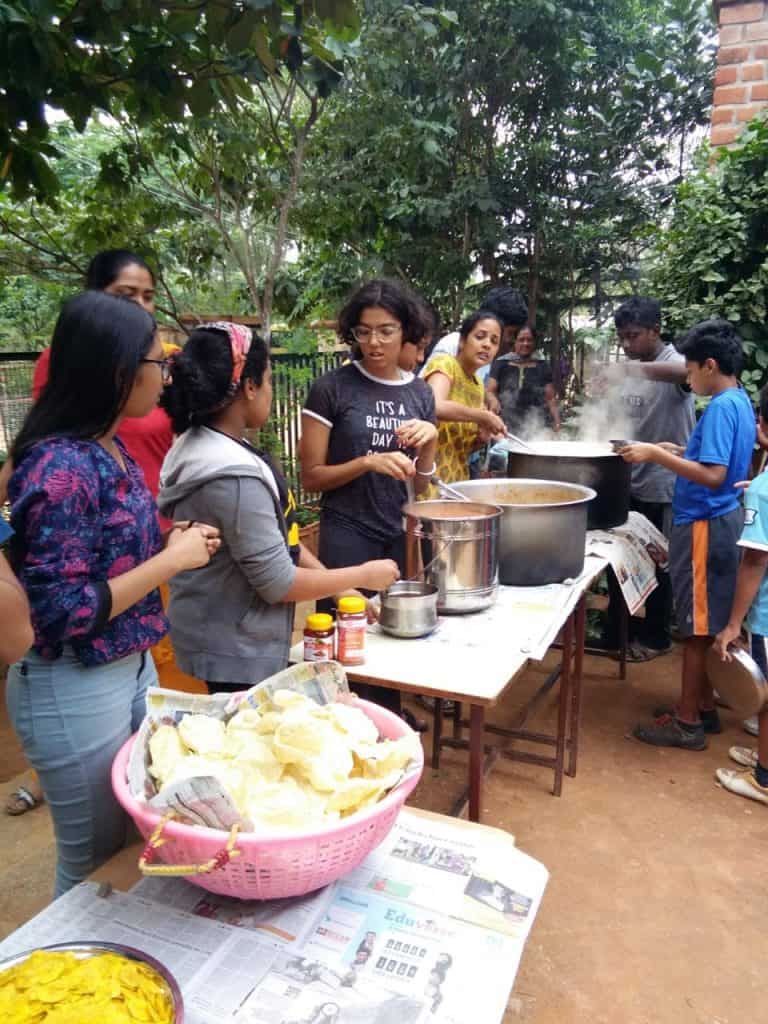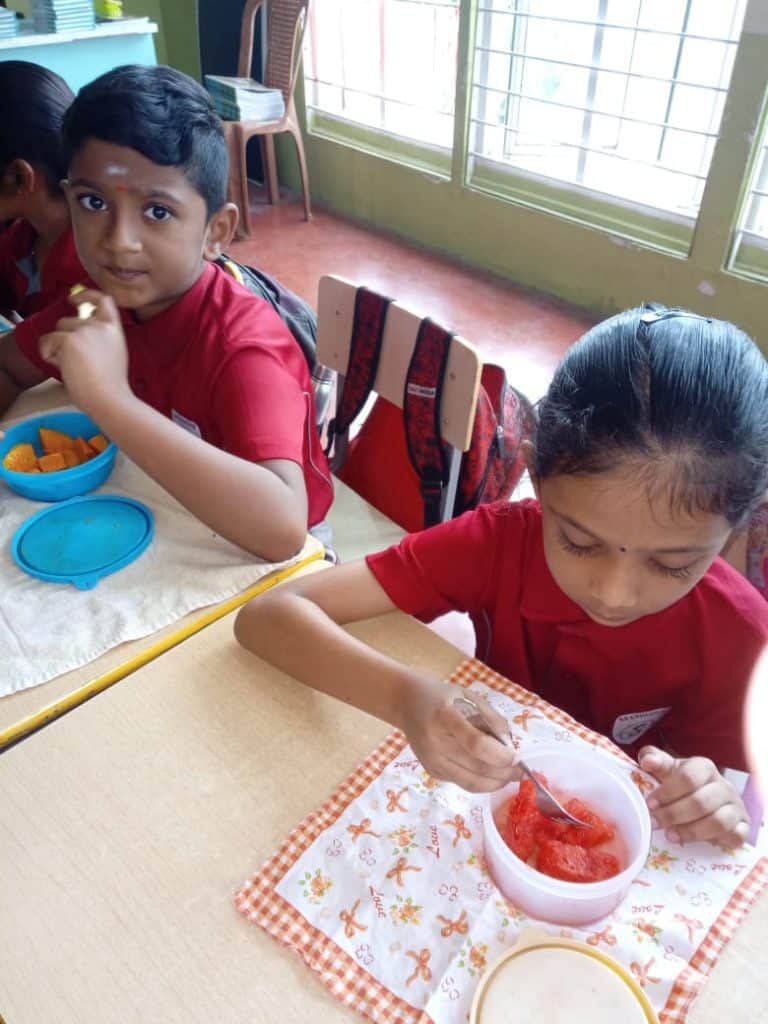Just like many students, I switched schools after 10th standard, and in the first week at my new school, I experienced a culture shock of sorts.
Till 10th standard, I went to Prakriya Green Wisdom School, which had a very strict health-food-only policy. All the students ate in the school canteen that prepared simple meals from organic, minimally-processed material – some of which was even grown on campus.
The menu included dosa, idli, or poha for snack, roti or rice with sambar, a salad, a vegetable dish, buttermilk and payasam for lunch. Birthdays were celebrated with chikkis; chocolates or any kind of packaged food were disallowed.
The food policy in my 11th and 12th grade school was different. The school canteen served lunch consisting of roti and a vegetable dish, masala dosa, pulav with raita, or hakka noodles. A tuck shop served puffs and samosas for snacks, along with some pastries, chocolates, chips, ice creams and cup noodles. Seeing my classmates munching on samosas and slurping noodles for lunch was a bit of a shocker for me.
While healthy food is slowly becoming a trend in cities like Bengaluru, only some schools have adopted strict food policies. Most schools allow students to bring snacks and lunch from home, but also allows them to buy breakfast, snacks or lunch from their own canteens.
School canteens typically provide Indian food. According to a student of Greenwood High School, the school serves only vegetarian food for all three meals of the day. Coffee and milk, cereal, porridge, and sandwiches are offered for breakfast, along with a hot dish that includes dosa, uthappam or idli. Lunch includes roti, rice, a vegetable dish and a curry or dal. “The variety is really good. It’s diverse and it caters to North Indians and South Indians equally. It’s a very balanced kind of menu, with a good rotation of desserts,” says the student.
On the other hand, Inventure Academy offers non-vegetarian food also. Breakfast consists of milk, cereal, toast, hot dishes that include aloo paratha or dosa, and an egg dish. Lunch consists of a salad, rice, vegetable, and vegetarian and non-vegetarian sides. A recent graduate of Inventure says that the school provided a large variety of food in all their meals.
Some schools like Primus Public School, located off Sarjapur Road, do not have a canteen and allows students to bring their own food.
Alternative schools and food policies
The schools that do restrict unhealthy food are typically those that fall under the category of alternative schools – schools that espouse a non-traditional approach to teaching, believe in the holistic development of a student, and value sustainability and a connect with nature.
The Creative School, located near Kalkere, is one such school, and believes in hands-on learning and creativity. According to Shantala Bhat, an administrator at the school, “The philosophy of the school is not just education related to books. We believe in complete child development.”
The Creative School provides breakfast, a fruit snack, and lunch to students. They try to use as much organic food as possible. While the menu changes every day, breakfast includes idli or dosa with sambar or chutney, while lunch consists of roti, rice and vegetable side dishes.
When asked whether there has been any parental push-back about the restrictions, Shantala says that one of the criteria while admitting students was the extent to which the parent’s philosophy matched with that of the school.
“We have workshops throughout the year. Parents have to attend these workshops, so that they get aligned with our philosophy,” Shantala says.
Alignment with the school’s philosophy is the common thread with most alternative schools. Shibumi School, located in Somanahalli, tries to ensure that parents believe in the same ideas that the school does.
“The whole school works in a participatory mode in which the parents also believe in the same philosophy and share the school’s outlook. Parents have put their kids in such a school, because they believe in such things,” says Sapna Rawat, whose two children attend the school.
Shibumi is similar to The Creative School in that students eat meals prepared in the school itself. However, parent-volunteers also prepare food for the children during a slot called Shibumi care. The entire school is divided into groups that perform various tasks and chores around the school in rotation, and one of these groups is assigned preparation of food.
Parents mostly use organic material, ordering supplies from local organic vendors. While Indian food is mainly cooked, parents try to ensure some variety. “They make Indian food most of the time, but as you know, kids are aware of other kinds of food which they eat at their own homes – be it pasta, sandwiches, soup, noodles, chaat, rather than just roti, sabji and rice,” Sapna says.
Even among alternative schools that encourage healthy food, food policies and methods of implementing them differ. While some schools require students to eat food that is prepared in the school, Bengaluru schools like Saandeepani Academy for Excellence and Poorna Learning Centre allow students to bring their own food as long as it is not packaged food such as chips or biscuits.
Poorna Learning Centre, located in North Bengaluru, encourages healthy eating, but students are allowed to bring their own lunch and snacks, except on Wednesdays, when students and teachers prepare lunch together.

Students and faculty preparing lunch at Poorna Learning Centre. Pic courtesy: Indira Vijaysimha
Poorna originated from the experiences of Indira Vijaysimha, who had tried to home-school her children. Indira is currently a faculty member at Azim Premji University (APU). In an email interview, she said it was important for schools to have food policies since children spent the most active part of their days in school.
She said that the parents of students at Poorna were provided with written guidelines on the kind of food children could bring, and were told why they discouraged packaged food such as biscuits. However, she said that teachers did not monitor what children brought for lunch. “Directly monitoring what a child eats is too intrusive and can be counterproductive,” she added.
On Wednesdays, a group of students (on rotation) cook food for the entire Poorna community. Indira said that teachers discussed many issues around food and sustainability with students while they planned lunch. Washing up and cleaning utensils also provided opportunities to discuss issues around water, detergents, gender roles and so on, she added.
When students champion healthy food
Saandeepani Academy for Excellence, located in Sarjapur, doesn’t require students to eat in the canteen. But the student leaders or class teachers check lunch boxes to ensure that the students have not brought junk food. If a student has bought unhealthy food for snack or lunch, they are provided with an alternative, healthy school lunch.
For the annual Inventure Changemaker Project – a programme in which students engage in hands-on, entrepreneurial, community-centric projects – a team from Saandeepani named ‘Green Gobblers’ reached out to nearby schools and held workshops for parents. “In our workshops, we told the parents about junk food and healthy food, what made certain food junk, and why these were unhealthy,” says Kynsai Ria, a 10th standard student at Saandeepani Academy, and a member of the Green Gobblers.
The Green Gobblers have targeted students up to class three and their efforts have been pretty effective, adds Kynsai.
“We were in the local supermarket walking down the aisle with sweets and chocolates, and a kid from our school was telling his father, ‘Appa, we should not buy this, this is junk food’,” she says.
It is true students are often less than enthusiastic about non-packaged items, organic-only food policies. Pranav Rao, a student from one such school, acknowledges that his school tries to incorporate different flavours and textures, but says some students don’t like the food as it is not what they are used to eating at home. In his school, Chow chow bath and Ragi mudde are common crib generators.

Students eating snacks at Saandeepani Academy for Excellence. Pic courtesy: Jayanti Roy
Many students, myself included, had complained about the food provided at school – a bar of chocolate is a lot more appealing that a packet of dry-fruits. Besides, many schools, in the interest of ensuring that it is healthy, make mild, less spicy food (or “bland,” as students put it) that does not appeal to children.
According to Indira, healthy food can seem more palatable to children if they discover it for themselves. She gave an example of a child at Poorna who disliked eating vegetables. But when all the children took up gardening at school, the same child enthusiastically ate the carrots and potatoes that they had grown and harvested.
Ultimately, schools can only do so much with what they enforce or not, and what to eat is a personal choice. However, there are some habits that schools can instil at a young age.
I, for one, always think twice now before opening a packet of chips.